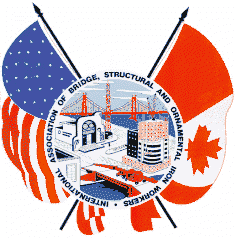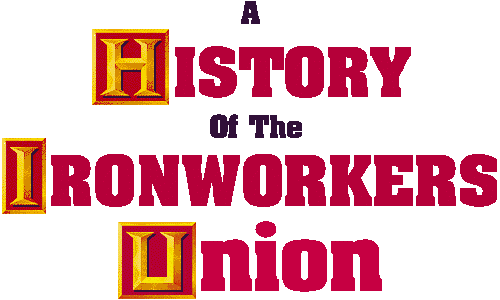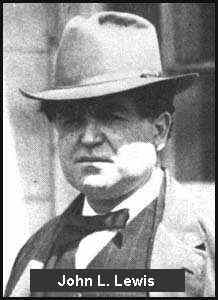|
|
|
||
|
Our History
A Union is Born
The Turbulent Years
The Conspiracy Trials
The Beginning of the
Morrin Era
The Depression and a New
Deal For Labor
World War II
Ironworkers Grow in the
1950's Part Two Part Three
John H. Lyons Jr.
Elected President
The Tradition Continues
Pathways to the 21st
Century Under The Leadership of General President Jake West
|
Part Three
In another editorial in February of 1934, Morrin pointed out the difference between Hoover and Roosevelt. While Hoover had given money to the big corporations through loans from the RFC, Roosevelt provided funds from the bottom to the workers to increase buying power and to get the factories running again.
BUILDING TRADES BOARD On January 31, 1934, General President P. J. Morrin was appointed to the Construction Industry Planning and Adjustment Board which was considered one of the most important agencies set up under the construction industry code. This board was charged with responsibility for the planning and the development of policies that embraced the broad spirit of cooperation and good will in promotion of better relations between employers and employees within the industry, and the furtherance of other matters of mutual employer-employee interest. President Roosevelt suggested that the Board make a study of trade jurisdictional disputes, their causes and origins, and methods for their prevention and amicable solution. Its findings and recommendations were to be submitted to the President for consideration and appropriate action. When the Supreme Court declared the National Industrial Recovery Act unconstitutional on May 27, 1935, the General Executive Board, through Representative Rueben T. Wood of the sixth Missouri District, a former President of the Missouri State Federation of Labor for twenty-five years, introduced House Bill 12499 to the Seventy-fourth Congress. The bill was intended to stabilize the structural steel fabrication and erection industry; to prevent monopoly conditions and practices therein; to provide for the general welfare; and for other purposes." This bill, however, was apparently held up in the Committee on Interstate and Foreign Commerce, and Congress adjourned before action could be taken. Meanwhile, other governmental projects, such as the Tennessee Valley Authority (TVA) and public works projects, put many unemployed Ironworkers back on the job, increasing wages as well as membership. By 1935 the Ironworkers had at least partially recovered from the terrible depression. In the mid-1930's a "kick-back" racket was investigated by the Committee on Education and Labor. It was discovered that contractors were evading the Prevailing Wage Law by forcing the worker to pay for his job by making deductions directly from his pay envelope. A worker on the Chicago Post Office construction project had to "kick-back" $472.50 in order to hold his job. Finally Congress passed the "Anti-Kick-Back Law" which provided a fine of not more than $5,000.00 or imprisonment for not more than five years, or both. But it would not be until May of 1935 that the first twelve contractors on government jobs would be found guilty.
WORKS PROGRESS ADMINISTRATION (WPA) APRIL 5, 1935 By February of 1936, 12.5 million would be employed on Federal jobs under the WPA program. Harry L. Hopkins, WPA Administer, stated that "not one worker in a hundred has shown preference for relief rather than work." THE NATIONAL LABOR RELATIONS ACT The National Labor Relations Act (better known as the Wagner Act) which passed on July 5, 1935, guaranteed the right of certain employees to freedom in self-organization, the designation of representatives of their own choosing for the purpose of collective bargaining. In addition, it prohibits employers from interfering with the right of employees to join a union, interference with any labor organization, to discriminate in hiring or firing, or to refuse to bargain collectively. The provisions of this act were amended in 1947. As early as 1934, Senator Wagner saw the need to put teeth in the labor provisions of the National Recovery Act. A group of fifty-eight lawyers working for the pro-management "Liberty league" called the Wagner Act Unconstitutional. The bill passed the Senate after two days of debate by a margin of 63-12. There was an attempt by Senator Tydings of Maryland for an amendment to allow company unions but it was defeated 50 to 21.
SOCIAL SECURITY ACT PASSED ON AUGUST 14, 1935 This Act and its subsequent amendments provide insurance to certain wage earners for loss of income due to unemployment or old age, and provides certain benefits for the protection for their families in the event of death. The Employer and the employee make equal contributions to provide for these benefits under the act. Twelve regional offices were set up. It would not be until May 24, 1937 that both the old age annuity and the unemployment insurance sections of the law would be declared constitutional by the Supreme Court. Before this Federal Legislation, only one state, Wisconsin, provided unemployment insurance.
THE FOUNDING OF THE CONGRESS OF INDUSTRIAL ORGANIZATIONS (CIO) John Llewellyn Lewis, the son
of immigrants from Wales, was born in Iowa on 12th February,
1880. At fifteen he found work as a miner in
Illinois. He joined the United Mine Workers of America (UMWA)
and eventually was elected branch secretary. In 1911
Lewis left the mines to On August 5, 1936 the Executive Council of the A. F. of L. called upon the organizations holding membership in the CIO to make their choice within thirty days as to whether they would withdraw from affiliation with the A. F. of L. or discontinue their membership in the Committee of Industrial Organization. On September 5, 1936 they recognized the CIO as a rival to the A. F. of L. There were one hundred two Internationals still remaining in the A. F. of L. Just as the steel companies had been hostile to the Iron Workers over the years, they continued to be hostile to this new labor organization.
Scroll to the top and click on
The Depression and a New Deal For
Labor - 1930 to 1940 - Part Four
[Home]
[Officers]
[Upcoming
Events] |



 become
an organizer for the American Federation of Labor
(AFL). In 1917 he was elected vice president of the
UMWA. Three years later he became president of what was
then the largest trade union in America. In 1921 Lewis,
with the support of William Z. Foster, failed in an attempt to
challenge Samuel Gompers for the presidency of the American
Federation of Labor.
become
an organizer for the American Federation of Labor
(AFL). In 1917 he was elected vice president of the
UMWA. Three years later he became president of what was
then the largest trade union in America. In 1921 Lewis,
with the support of William Z. Foster, failed in an attempt to
challenge Samuel Gompers for the presidency of the American
Federation of Labor.